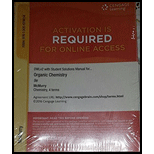
Concept explainers
Interpretation:
The reason why cysteine has R configuration while all the others have S configuration.
Concept introduction:
Except glycine, all the other 19 amino acids have chiral centers and hence can occur as two enantiomers. But the naturally occurring enantiomers resemble the L sugars, i.e. placing the CO2- group at the top and pointing the side chain downwards and the NH3 group on the left. These usually have S configuration, which is dependent on the priority of the attached molecules. But this is not the case for cysteine as it has R configuration.
To determine:
Why cysteine is the L amino amino acid that occurs in R configuration naturally?
Want to see the full answer?
Check out a sample textbook solution
Chapter 26 Solutions
OWLv2 with Student Solutions Manual eBook, 4 terms (24 months) Printed Access Card for McMurry's Organic Chemistry, 9th
- Don't used hand raiting and don't used Ai solutionarrow_forwardWhat is the name of the major product formed during the reaction between benzoyl chloride and phenol? benzyl ester O phenyl benzoate ○ cyclopentanoate ○ benzyl phenoate ○ benzenecarboxylic acidarrow_forwardProvide the proper IUPAC or common name for the following compound. Dashes, commas, and spaces must be used correctly.arrow_forward
- Provide the proper IUPAC name (only) for the following compound. Dashes, commas, and spaces must be used correctly. HO. OHarrow_forwardQuestion 2 0/1 pts Provide the proper IUPAC name only for the following compound. Dashes, commas, and spaces must be used correctly. HO CH 3 1-methyl-1-cyclohexanecarboxylic acidarrow_forwardPlease assign all the carbons for C-NMR and hydrogen for H-NMR. Please if I can get that less than hourarrow_forward
- Please can I have e mechanism for this equation, handwriting pleasearrow_forward3. For the following reaction, what are the major product(s) mechanism for this reaction ? and draw the full Br Brarrow_forward4. Show the product(s) for the following reaction if it proceeds via the S42 mechanism AND if it proceeds via an Syt mechanism? Draw the mechanisms for both reactions and show all resonance structures for any intermediates. Would you expect the Su or Sy2 reaction to be favoured and why? NGOarrow_forward
 General, Organic, and Biological ChemistryChemistryISBN:9781285853918Author:H. Stephen StokerPublisher:Cengage Learning
General, Organic, and Biological ChemistryChemistryISBN:9781285853918Author:H. Stephen StokerPublisher:Cengage Learning Organic And Biological ChemistryChemistryISBN:9781305081079Author:STOKER, H. Stephen (howard Stephen)Publisher:Cengage Learning,
Organic And Biological ChemistryChemistryISBN:9781305081079Author:STOKER, H. Stephen (howard Stephen)Publisher:Cengage Learning,
 Chemistry for Today: General, Organic, and Bioche...ChemistryISBN:9781305960060Author:Spencer L. Seager, Michael R. Slabaugh, Maren S. HansenPublisher:Cengage Learning
Chemistry for Today: General, Organic, and Bioche...ChemistryISBN:9781305960060Author:Spencer L. Seager, Michael R. Slabaugh, Maren S. HansenPublisher:Cengage Learning Organic ChemistryChemistryISBN:9781305580350Author:William H. Brown, Brent L. Iverson, Eric Anslyn, Christopher S. FootePublisher:Cengage Learning
Organic ChemistryChemistryISBN:9781305580350Author:William H. Brown, Brent L. Iverson, Eric Anslyn, Christopher S. FootePublisher:Cengage Learning




